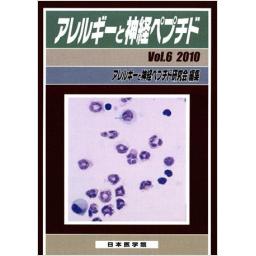1) 日本アレルギー学会(西間三馨・監):アレルギー疾患 診断・治療ガイドライン 2007, 協和企画, 東京, 2007.
アレルギーと神経ペプチド Vol.6 2010年
商品紹介
第6回アレルギーと神経ペプチド編集会議での内容をもとに、“精神的ストレスと喘息”という経験的にはよく知られているが、科学の光を当てにくい分野について紹介。その他の基礎・臨床に関する論考なども収録。
目次
- アレルギーと神経ペプチド Vol.6 2010年
―目次―
特集 “ストレスと気道アレルギー”
PRESENTATION
ストレス喘息とμオピオイド受容体
COMMENT & IMPRESSION
“ストレス喘息とμオピオイド受容体”を聞いて
ストレスと免疫応答に関しては過去多くの興味深い研究がある
上気道とストレス
喘息発作とストレス
気管支喘息の憎悪におけるストレスの関与
ストレス、皮膚アレルギー、そしてステロイド
中枢神経系および末梢神経系におけるμオピオイド受容体の作用
REVIEW&TOPICS
喘息気道リモデリングのCT画像による評価
神経ペプチドneuromedin Uとneuromedin S
COX-2とvasoactive intestinal peptide(VIP)
オロパタジンによるヒスタミン非依存性の痒みの制御の可能性
EDUCATIONAL LECTURE
TRPチャネルを介した温度受容の分子機構
WAVE OF MEDICINE
“ニューロペプタイド研究会のあゆみ”第17回研究会報告
DRUG-REPORT
TRPM8チャネルと皮膚感覚
文献紹介
1.乾癬の増悪における神経系因子の変化(EI-Nour H et al.)
2.通年性鼻アレルギー患者鼻粘膜における神経増殖因子の局在
(Bresciani M et al.)
3.新規CB2受容体刺激薬(GW833972A)のモルモットとヒトの
気道における知覚神経機能の阻害活性(Belvisi MG et al.)
この書籍の参考文献
参考文献のリンクは、リンク先の都合等により正しく表示されない場合がありますので、あらかじめご了承下さい。
本参考文献は電子書籍掲載内容を元にしております。
特集に寄せて
P.2 掲載の参考文献
特集 "ストレスと気道アレルギー"
P.10 掲載の参考文献
P.12 掲載の参考文献
P.13 掲載の参考文献
6) Kalogeronlitros D, Syrigou EK, Makris M et al.:Nasal provocation of patients with allergic rhinitis and the hypotha-lamic-pituitary-adrenal axis. Ann Allergy Asthma Immunol 98:269-273, 2007.
7) Kventnansky R, Hukuhara K, Pacak K et al.:Endogenous glucocorticoids restrain catecholamine synthesis and release at rest and during immunobilization stress in rats. Endocrinology 133:1411-1419, 1993.
P.20 掲載の参考文献
1) 秀 道広・他:蕁麻疹・血管性浮腫の治療ガイドライン. 日皮会誌 115:703-715, 2005.
2) Chida Y et al.:The effects of psycho-logical intervention on atopic dermatitis. A systematic review and meta-analysis. Int Arch Allergy Immunol 144:1-9, 2007.
3) 古江増隆・他:アトピー性皮膚炎診療ガイドライン. 日皮会誌 119:1515-1534, 2009.
REVIEW & TOPICS
P.26 掲載の参考文献
5) 新実彰男, 小熊 毅:喘息におけるCT画像. 呼吸器科 14:337-384, 2008.
13) Yamaguchi M, Niimi A, Matsumoto H et al.:Sputum levels of transforming growth factor-β1 in asthma:Relation to clinicoradiological findings. J Invest Allergol Clin Immunol 18:202-206, 2008.
P.30 掲載の参考文献
4) Miyazato M, Mori K, Ida T, Kojima M, Murakami N, Kangawa K:Identification and functional analysis of a novel ligand for G protein-coupled receptor, Neuromedin S. Regul Pept 145(1~3):37-41, 2008.
7) Fisher JM, Scheller RH:Prohormone processlng and the secretory pathway. J Biol Chem 263(32):16515-16518, 1988.
P.34 掲載の参考文献
2) Matsuo M, Yonemitsu N, Zaitsu M et al.:Expression of prosta-glandin H synthasc-2 in human brain tumors. Acta Neuropathol 102:181-187, 2001.
10) Delgado M, Abad C, Martinez C et al.:Vasoactive Intestinal pep-tide prevents experimental arthritis by down-regulating both auto-immune and inflammatory components of the disease. Nat Med 7:563-568, 2001.
P.38 掲載の参考文献
1) 日本皮膚科学会アトピー性皮膚炎診療ガイドライン作成委員会 ; 古江増隆, 佐伯秀久, 古川福実・他:アトピー性皮膚炎診療ガイドライン. 日皮会誌 119:1515-1534, 2009.
3) 川島 眞, 原田昭太郎:抗アレルギー薬を併用した標準的薬物療法がアトピー性皮膚炎患者の痒みとQuality of Life (QOL)に及ぼす影響に関する調査. 臨床皮膚科 60:661-667, 2006.
5) Heyer G, Hornstein OP, Handwerker HO:Reactions to intradermally injected substance P and topically applied mustard oil in atopic dermatitis patients. Acta Derm Venereol 71:291-295, 1991.
6) Andoh T, Nagasawa T, Satoh M et al.:Substance P induction of itch-associated response mediated by cutaneous NK1 tachykinin receptors in mice. J Pharmacol Exp Ther 286:1140-1145, 1998.
10) Matsubara M, Tamura T, Ohmori K et al.:Histamine H1 receptor antagonist blocks histamine-induced proinflammatory cytokine production through inhibition of Ca2+-dependent protein kinase C, Raf/MEK/ERK and IKK/IκB/NF-κB signal cascades. Biochem Pharmacol 69:433-449, 2005.
12) Macfarlane SR, Seatter MJ, Kanke T et al.:Proteinase-activated receptor. Pharmacol Rev 53:363-400, 2001.
14) Steinhoff M, Neisius U, Ikoma A et al.:Proteinase-activated receptor-2 mediates itch:a novel pathway for pruritus in human skin. J Neurosci 23:6176-6180, 2003.
17) 祥 宰, 清水和宏, 佐藤伸一:ストレスによって増強された皮膚炎に対するオロパタジン塩酸塩の抑制効果. 臨牀と研究 85:568-572, 2008.
20) 竹中 基, Bae Sang Jae, 佐藤伸一:アトピー性皮膚炎血漿中のサブスタンスPと末梢血単球での neural endopeptidase mRNAの発現の推移についての検討. 臨牀と研究 84:278-282, 2007.
EDUCATIONAL LECTURE
P.45 掲載の参考文献
DRUG-REPORT
P.53 掲載の参考文献
2) Tsavaler L, Shapero MH, Morkowski S, Laus R:Trp-p8, a novel prostate-specific gene, is up-regulated in prostate cancer and other malignancies and shares high homology with transient receptor potential calcium channel proteins. Cancer Res 61:3760-3769, 2001.
最近チェックした商品履歴
Loading...
